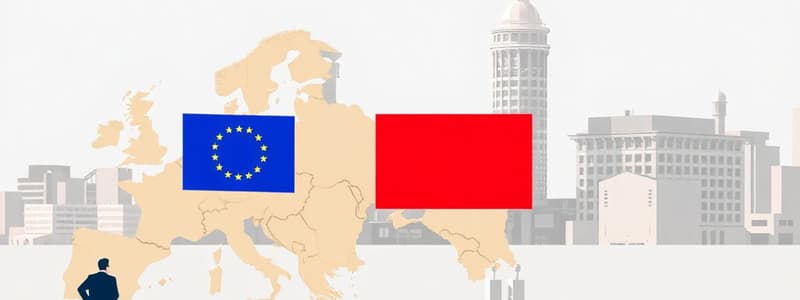Podcast
Questions and Answers
Which of the following best describes the key difference between a Customs Union and a Free Trade Area (FTA)?
Which of the following best describes the key difference between a Customs Union and a Free Trade Area (FTA)?
- A Customs Union establishes a common external tariff for non-members, while a Free Trade Area maintains individual tariffs. (correct)
- A Customs Union allows free movement of labor, while a Free Trade Area restricts it.
- A Customs Union harmonizes all economic policies, while a Free Trade Area focuses only on trade.
- A Customs Union eliminates all tariffs, while a Free Trade Area only reduces them.
What is the primary characteristic that distinguishes an Economic and Monetary Union (EMU) from a Single Market?
What is the primary characteristic that distinguishes an Economic and Monetary Union (EMU) from a Single Market?
- An EMU eliminates all tariffs, while a Single Market only reduces them.
- An EMU allows free movement of goods, services, and capital, while a Single Market only focuses on goods.
- An EMU harmonizes economic and monetary policies among member states, while a Single Market focuses on the free movement of goods, services, capital, and labor. (correct)
- An EMU requires a common government, while a Single Market allows individual governments.
The 'four freedoms' are a key component of the single market. Which of these is NOT one of the four freedoms?
The 'four freedoms' are a key component of the single market. Which of these is NOT one of the four freedoms?
- Free movement of capital
- Free movement of people
- Free movement of currency (correct)
- Free movement of goods
Which concept, established in a key EU ruling, allows an individual to enforce EU law directly in their national court, even if national law conflicts?
Which concept, established in a key EU ruling, allows an individual to enforce EU law directly in their national court, even if national law conflicts?
The 'Brussels Effect' is an example of:
The 'Brussels Effect' is an example of:
What does 'negative integration' primarily involve in the context of economic integration?
What does 'negative integration' primarily involve in the context of economic integration?
In the context of EU law, what does the principle of supremacy, established in Costa v. ENEL (1964), entail?
In the context of EU law, what does the principle of supremacy, established in Costa v. ENEL (1964), entail?
According to the principle of mutual recognition, what condition allows a member state to restrict the sale of a product legally sold in another member state?
According to the principle of mutual recognition, what condition allows a member state to restrict the sale of a product legally sold in another member state?
Which of the following best describes the 'Snake in the Tunnel' arrangement in the context of European monetary history?
Which of the following best describes the 'Snake in the Tunnel' arrangement in the context of European monetary history?
What was the primary objective of the Stability and Growth Pact (SGP) established in 1997?
What was the primary objective of the Stability and Growth Pact (SGP) established in 1997?
Which stage of the Economic and Monetary Union (EMU) involved the establishment of the European Central Bank (ECB)?
Which stage of the Economic and Monetary Union (EMU) involved the establishment of the European Central Bank (ECB)?
Why was there a German fear that the Euro would be a weak currency during its initial planning stages?
Why was there a German fear that the Euro would be a weak currency during its initial planning stages?
According to the theory of Optimum Currency Area (OCA), what is a critical requirement for countries to successfully share a single currency?
According to the theory of Optimum Currency Area (OCA), what is a critical requirement for countries to successfully share a single currency?
What was the primary political motivation behind the Maastricht plan, according to the provided information?
What was the primary political motivation behind the Maastricht plan, according to the provided information?
During the second stage of the EMU (1994-1998), what key criteria did member states need to meet to demonstrate convergence?
During the second stage of the EMU (1994-1998), what key criteria did member states need to meet to demonstrate convergence?
What is the purpose of the 'no bailout clause' within the Eurosystem's framework?
What is the purpose of the 'no bailout clause' within the Eurosystem's framework?
Which of the following is the MOST significant challenge for a currency union lacking fiscal federalism during an economic downturn?
Which of the following is the MOST significant challenge for a currency union lacking fiscal federalism during an economic downturn?
In what way would a banking union MOST effectively address a financial crisis within a currency union, such as the Eurozone?
In what way would a banking union MOST effectively address a financial crisis within a currency union, such as the Eurozone?
How do the EU's redistributive powers MOST directly contribute to economic stability within the union?
How do the EU's redistributive powers MOST directly contribute to economic stability within the union?
Which of the following scenarios BEST illustrates the EU's regulatory powers being used to ensure fair competition?
Which of the following scenarios BEST illustrates the EU's regulatory powers being used to ensure fair competition?
What was the PRIMARY goal of the European Financial Stability Facility (EFSF) and the European Stability Mechanism (ESM) in response to the Eurozone crisis?
What was the PRIMARY goal of the European Financial Stability Facility (EFSF) and the European Stability Mechanism (ESM) in response to the Eurozone crisis?
What is the MOST likely outcome of a country within a currency union having a significantly different economic structure compared to other member states?
What is the MOST likely outcome of a country within a currency union having a significantly different economic structure compared to other member states?
Which condition is MOST crucial for an Optimal Currency Area (OCA) to function effectively when a member state experiences an economic downturn?
Which condition is MOST crucial for an Optimal Currency Area (OCA) to function effectively when a member state experiences an economic downturn?
How did changes to the Stability and Growth Pact (SGP) aim to prevent future debt crises in the EU?
How did changes to the Stability and Growth Pact (SGP) aim to prevent future debt crises in the EU?
What is the PRIMARY source of funding for the EU budget, which is then used for expenditure powers?
What is the PRIMARY source of funding for the EU budget, which is then used for expenditure powers?
Flashcards
Free Trade Area (FTA)
Free Trade Area (FTA)
Tariffs are eliminated between member countries, but each country maintains its own tariffs for non-members.
Customs Union
Customs Union
Internal tariffs are eliminated, and a common external tariff is established for non-members.
Single Market
Single Market
Free movement of goods, services, capital, and labor between member states.
Economic and Monetary Union (EMU)
Economic and Monetary Union (EMU)
Signup and view all the flashcards
Political Union
Political Union
Signup and view all the flashcards
Negative Integration
Negative Integration
Signup and view all the flashcards
Positive Integration
Positive Integration
Signup and view all the flashcards
Mutual Recognition
Mutual Recognition
Signup and view all the flashcards
Bretton Woods System
Bretton Woods System
Signup and view all the flashcards
European Currency Unit (ECU)
European Currency Unit (ECU)
Signup and view all the flashcards
Maastricht Criteria
Maastricht Criteria
Signup and view all the flashcards
Stability and Growth Pact (SGP)
Stability and Growth Pact (SGP)
Signup and view all the flashcards
Medium-Term Budgetary Objective
Medium-Term Budgetary Objective
Signup and view all the flashcards
Excessive Deficit Procedure (EDP)
Excessive Deficit Procedure (EDP)
Signup and view all the flashcards
Optimum Currency Area (OCA)
Optimum Currency Area (OCA)
Signup and view all the flashcards
No Bailout Clause
No Bailout Clause
Signup and view all the flashcards
High Factor Mobility
High Factor Mobility
Signup and view all the flashcards
Similar Economic Structure
Similar Economic Structure
Signup and view all the flashcards
Fiscal Federalism
Fiscal Federalism
Signup and view all the flashcards
Banking Union
Banking Union
Signup and view all the flashcards
EU Regulatory Powers
EU Regulatory Powers
Signup and view all the flashcards
EU Redistributive Powers
EU Redistributive Powers
Signup and view all the flashcards
EU Expenditure Powers
EU Expenditure Powers
Signup and view all the flashcards
EFSF
EFSF
Signup and view all the flashcards
ESM
ESM
Signup and view all the flashcards
Study Notes
- Economic integration occurs step-by-step, involving increased cooperation between countries.
Stages of Economic Integration
- Free Trade Area (FTA): Member countries eliminate tariffs between themselves, but each retains individual tariffs for non-members.
- Customs Union: Internal tariffs are removed, and a common external tariff is established.
- Single Market: Allows the free movement of goods, services, capital, and labor among member states.
- Economic and Monetary Union (EMU): Member states coordinate economic and monetary policies, including adopting a common currency like the euro.
- Political Union: Characterized by a common government with integrated economic and political decision-making.
The Single Market
- Began with the Treaty of Rome (1957), with the goal of closer integration among European nations.
- The initial objective was a customs union, with the single market to follow.
- The Single European Act (1986) targeted the creation of the single market by 1992.
- Four Freedoms: The single market ensures the free flow of goods, services, capital, and people.
- 1985 Delors Commission resulted in the completion of the internal market, alongside the Schengen Area.
- 1988 Cecchini Report assessed the costs and benefits of the EU common market.
Integration Measures
- Negative integration: Involves removing physical, fiscal, and technical barriers to trade
- Mutual recognition principle: An example of negative integration, came from the Cassis de Dijon case
- Positive integration: Involves establishing common standards for social and environmental norms.
- "Brussels Effect:" EU regulations often become global standards due to the EU's market size.
Key Rulings for EU Law
- Van Gend en Loos (1963): A Dutch company claimed the Netherlands had violated EU law by imposing tariffs on imported goods.
- Established the principle of direct effect so individuals can enforce EU law in national courts.
- Costa v. ENEL (1964): Mr. Costa challenged Italy's electricity sector as conflicting with EU law.
- Established the principle of supremacy, meaning EU law overrides national law
- Cassis de Dijon (1979): A German importer was denied the ability to seel French liquor.
- Introduced mutual recognition: a product legally sold in one member state must be accepted in others
The Eurosystem
- The path to the euro began with the fixation of exchange rates:
- Bretton Woods system: A fixed exchange rate system until 1973, where currencies were linked to the US dollar.
- Snake in the tunnel: European currencies were pegged to each other and the dollar.
- Snake outside the tunnel: Currencies were only pegged to each other with a Å}2.25% fluctuation margin.
- The European Currency Unit (ECU) was introduced as banking currency.
Three Stages of EMU
- 1990-1993: Free movement of capital, closer economic policy coordination, and cooperation between central banks.
- 1994-1998: Convergence with Maastricht criteria compliance.
- Since 1999: Establishment of the European Central Bank (ECB), fixed exchange rates, and the introduction of the Euro.
- The Maastricht plan contained Germany after the end of the Cold War and German reunification
Maastricht Convergence Criteria
- To join the EMU, member states needed to meet strict economic criteria.
- Stability and Growth Pact 1997 was agreed upon ains to ensure ongoing fiscal discipline after euro adoption including: medium-term budgetary objective, and a limit through the excessive deficit procedure (EDP).
- Financial penalties in countries with excessive deficits
- There was fear of high public debt, as well as German fear that the Euro would be a weak currency.
- No bailout clause: governments would not assume each other's debts.
Theory: Optimum Currency Area (OCA)
- An optimum currency area (OCA) is an area closely linked by trade in goods, services, and factor mobility.
- Member states should only share a single currency if they can support each other economically during crises.
- In a currency union, devaluing the currency is not possible; member states need alternative ways to manage economic differences.
OCA Requirements
- High factor mobility: Production factors can easily move between countries or regions.
- Similar economic structure
- Fiscal federalism: Wealthier members support struggling members through financial transfers to maintain stability.
Banking Union
- Unified banking system where regulation and supervision occur at the currency union level
- If national banks are at risk the banking union would allow for coordinated oversight.
EU's Economic Leverages
- Regulatory Powers: Setting market standards, antitrust regulations, and merger controls.
- Redistributive Powers: Cohesion, agricultural, and structural funds.
- Expenditure Powers: EU budget funded by VAT, customs duties, and national contributions.
Eurozone Crisis
- The financial crisis began in Greece (2009) and spread.
- The European Financial Stability Facility (EFSF) was introduced, and European Stability Mechanism (ESM) was introduced.
- Changes to rules of Stability and Growth Pact were introduced to keep EU countries budgets in check
SGP Rules
- importance of deficit and debt was reinforced
- The role of the European Commission in monitoring public finances was enhanced The Banking Union: Strengthened regulation of the banking sector.
- Corona Rescue Package (Next Generation EU), divided into loans and grants, to recover the post COVID-19 economy
- Joint borrowing by the EU Spending is controlled by peer monitoring.
- Money will be used to focus on digitalization and green innovations.
The Next Turn in the Single Market
- European Green Deal: Launched in 2019 to make Europe climate-neutral by 2050.
- Updated 2030 target: Reduce greenhouse gas emissions by at least 55% compared to 1990 levels.
- Rebranding as a 'clean, just, and competitive transition', because of the political opposition
- Digital Single Market
- Focus on digitalization of the single market.
- Post-COVID rescue fund supports digital, innovative, and green businesses.
Studying That Suits You
Use AI to generate personalized quizzes and flashcards to suit your learning preferences.




